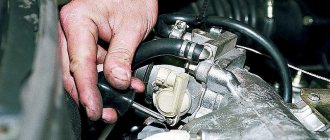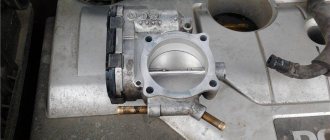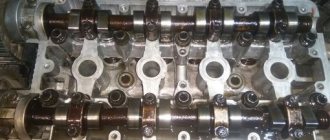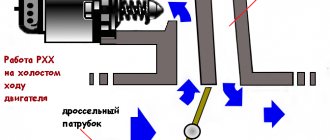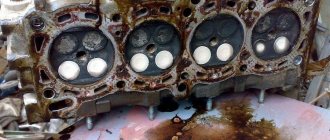Element characteristics
The throttle valve is a structural component of the intake system of gasoline internal combustion engines. Its main purpose is to regulate the amount of air entering the engine. In other words, this element controls the mixing of air with fuel in certain proportions. The DPS of VAZ and many other domestic cars is installed between the intake manifold and the air filter.
View gallery
Varieties
There are two types of TPS. What are these elements? This can be a part with a mechanical or electrical drive. The first is often used on budget cars. All its constituent elements are combined into a separate block, which includes such details as:
- Frame.
- Throttle valve.
- Sensor.
- IAC (idle air control).
View gallery
The damper body is included in the vehicle's cooling system. There are also pipes here that ensure the operation of gasoline vapor recovery and crankcase ventilation systems.
The idle speed regulator maintains the engine crankshaft speed when the throttle is closed during engine startup and warm-up or when additional equipment is operating. The IAC consists of a stepper motor and a valve. These two parts regulate the flow of air that enters the intake system bypassing the damper.
However, in the last few years, more and more automakers are equipping their vehicles with electrically operated throttle bodies. Such elements have their own electronic control system, which ensures the optimal amount of torque at all speed ranges and loads of the machine. This not only increases power and dynamics, but also reduces fuel consumption and exhaust emissions.
Cleaning the throttle valve VAZ 2110
Timely replacement, prevention and repair are the main points of extending the service life of automotive components, by observing which you can protect yourself from a number of unpleasant and costly consequences. As for the throttle assembly, it requires mandatory periodic maintenance with partial disassembly and cleaning after 50-60 thousand kilometers traveled; I have previously written on this topic here. How is the throttle valve cleaned on a VAZ 2110? Let's figure it out.
To begin with, I will draw your attention to the so-called “symptoms of the disease” that require immediate response
So, in what cases does the damper need to be cleaned?
- You have noticed that when you suddenly release the accelerator pedal, it is quite difficult for your engine to switch to idle speeds from high speeds. This applies, for example, to those cases when you release the car to “neutral” at 500-600 rpm instead of the standard smooth return. After which the engine stalls, accompanied by shaking, or is restored to the required speed, but with considerable difficulty.
- You notice difficulty in “cold” (in more severe cases, “hot”) starting the engine. In order for the car to start, you have to turn the starter for a long time and feel the “exhaust” smell of gasoline. At the same time, you note that the engine can be “revived” by jerky pressing movements on the gas pedal.
Why does the throttle valve become dirty?
Microscopic dust particles passing through the air filter from the crankcase gas system, a mixture of oil and air, slowly but surely cover the internal surfaces of the car. Places with strong air turbulence are more susceptible to fouling than others. This is the idle air control rod (IAC) and the place behind the throttle valve. With long-term operation and exposure to “overgrowth,” the throughput of the IAC bypass channel in the throttle is reduced.
Step-by-step instructions for cleaning the throttle valve of a VAZ 2110 with your own hands.
Attention: carry out work with a “cold” engine to avoid burns and other troubles. 1
Buy a set of screwdrivers + a special liquid that washes diesel fuel (for example, Abro - a reliable and inexpensive cleaner for carburetors) and a socket head for “13”
1. Buy a set of screwdrivers + a special liquid that washes diesel fuel (for example, Abro - a reliable and inexpensive cleaner for carburetors) and a socket head for “13”.
2. Armed with the above, get down to business. Remove the decorative plastic motor cover. Unscrew the expansion tank cap. This will reduce the pressure in the cooling system.
3. Loosen the clamps.
4. Then proceed to remove the forced ventilation hose of the air pipe. Take a closer look. If you find traces of oil in the air pipe, you can assume that the narrow forced ventilation channel is already clogged. If suspicions are justified, then oil particles and crankcase gases will flow through the large ventilation branch.
5. Loosen the two clamps using a screwdriver.
6. Remove and temporarily plug (you can use unsuitable spark plugs) the throttle valve heating hoses. Unscrew the clamp. Next, remove the fuel tank ventilation system hose.
7. Remove the cable and unscrew the nuts securing the throttle assembly (2 pcs.).
8. Now you will need the previously purchased cleaner. Use it to clean the throttle valve along with all its channels. In extremely difficult places (calibrated forced crankcase ventilation duct), you can use a needle or a steel knitting needle to clean heavily coked areas.
9. Proceed to remove the IAC by unscrewing two bolts. Very carefully rinse the latter channel in the throttle body. If a “wedge” of the IAC rod is detected, it is heavily contaminated and is accompanied by large play or wear, it is better to replace it with a new one.
10. Reassemble the parts in reverse order.
Differences between an electric damper
How does this part differ from its mechanical counterparts? Its main differences lie in the absence of a mechanical connection between the gas pedal and the throttle valve, as well as in the regulation of idle speed by moving the damper itself.
View gallery
But that's not all of its features. Since there is no rigid connection between the gas pedal and the throttle valve, the electronic system itself can influence the amount of torque of the internal combustion engine, even if the driver does not press the accelerator. All these changes occur due to the actions of the input sensors, control unit and actuator.
In addition to the TPS, the electronic control system contains an accelerator pedal position sensor, as well as a brake and clutch position switch. Thus, the engine control unit responds to all signals from the sensors and converts these impulses into control actions on the damper module.
The principle of operation of the VAZ 2107 injection engine
Unlike carburetor systems, where the preparation of the air-fuel mixture occurs in the carburetor chambers, the injection system involves injecting fuel directly into the cylinders. Therefore, such a system is called a “distributed injection system”.
Injection systems are qualified depending on the principle of operation and the number of injectors. “Seven” is equipped with a separate injection system with 4 nozzles (one per cylinder). VAZ 2107 injectors are controlled by a microcontroller of the electronic engine control unit. It regulates the flow of fuel into the cylinders depending on the operating mode, the position of the gas pedal and other parameters read by special sensors.
The ECU (electronic control unit) controls the amount of fuel and air entering the engine combustion chambers. In addition, it controls the formation of a spark on the spark plugs, changing the timing depending on the speed. The ECU also turns the fuel pump on and off, regulates idle speed, controls the amount of CO in the exhaust gases, and the temperature of the coolant in the cylinder block. It all works as follows.
Gasoline from the tank, passing through the fuel filter, is supplied by a pump to the fuel rail. The latter has a pressure regulator that regulates the flow of fuel to the injectors. A pressure of 300 MPa is maintained in the fuel rail, and excess fuel is sent to the gas tank through the return pipe.
The electronic control unit opens and closes the injectors, ensuring that gasoline is supplied to the intake manifolds with each engine revolution. The amount of fuel entering the cylinder depends on the time during which the injector is open. The ECU calculates this time based on the readings of many sensors. The main indicators that affect the injector opening time are information from the mass air flow sensor and the throttle position sensor. The opening moment of the injector is determined based on the position of the pistons in the cylinder, which is transmitted to the ECU by the crankshaft sensor.
Other parameters are also taken into account:
- coolant temperature, which affects the combustion process of the fuel mixture;
- on-board network voltage, on which the injector response time depends;
- engine speed;
- exhaust gas composition.
Module design features
This element includes such mechanisms as:
- Frame.
- Throttle valve.
- Electric motor.
- Gearbox.
- Throttle position sensor.
- Return spring mechanism.
View gallery
Sometimes 2 TPS are installed in a car at once. What does this do to the car? In principle, this does not add any power, however, if one sensor malfunctions, the second one can continue working. Thus, the installation of two TPS is carried out to increase the reliability of the module. These elements can be either non-contact or with sliding contact. The module design also includes an emergency damper position. It operates thanks to a return spring mechanism. If a module malfunctions, it is replaced as a whole assembly.
Causes and first symptoms of failure
If there is a need to set up or adjust a contact or non-contact TPS, first you need to understand the causes and symptoms of the malfunction. Therefore, we suggest you find out how to check the throttle position sensor yourself. In fact, any car enthusiast, even a beginner, can determine that the device has failed; the main thing is to know about the main signs. So, what types of throttle position sensor malfunctions exist and how do they manifest themselves?
Non-contact regulator disassembled
- The vehicle's engine begins to work unstably. It functions normally for a while, after which it may simply stall at idle. At idle speed, the internal combustion engine, as a rule, operates unstably, and when you try to reduce the speed from maximum to idle, the unit stalls.
- Another sign is that when the driver presses the gas pedal, the car either over-throttles itself or, on the contrary, stalls.
- An important sign is that at the first or third speeds the car seems to fail, the power is sharply lost, after which it can recover on its own.
- Jerks. This symptom usually appears when the damper itself is open.
As for failures, in this case it will not be possible to configure or adjust the device - this still will not help solve the problem. Such a malfunction usually occurs if the damper adaptation was unsuccessful or a fake was installed instead of the original TPS.
It is worth mentioning separately about fakes - non-original devices are characterized by the fact that in most cases they always depend on the temperature regime, so neither setting nor adjustment helps them. Accordingly, if the TPS heats up, its power level will also change. For example, if when the engine is turned off, the regulator shows one output voltage, then after the unit warms up, this parameter will begin to increase rapidly (video author - Ivan Vasilyevich).
In turn, the control unit will not be able to respond in a timely manner to an increase in this indicator, and this, one way or another, will affect the functioning of the machine, especially when changing gears. If you are not sure of the functionality of the element, then the throttle position sensor is checked. Simply turn off the ignition, then immediately start the engine - the control unit will show the last power supply parameter - the regulator with the throttle closed. If, after restarting, the motor operates stably, this indicates a problem with the TPS operation - these actions will only help correct the situation temporarily, but the regulator needs to be replaced as quickly as possible.
TPS: malfunctions
Like any other part, the throttle position sensor tends to fail. In this case, you need to know the main symptoms of its breakdown. So, what are the signs of a malfunction in the TPS?
View gallery
First of all, you should pay attention to the engine's idle speed. If its speed “floats”, this may indicate that the sensor is not working properly. Also, a symptom of its malfunction may be the engine stopping when the gas pedal is suddenly released. The malfunction of the sensor is very noticeable when accelerating the car. In this case, there may be failures when accelerating (it seems as if no fuel is entering the engine at all). Sometimes when driving, the car may not respond to the gas pedal. In addition, the engine speed may freeze at 1.5-3 thousand and not drop even when the gear is off and idling. That is, signs of malfunction of this element are directly related to the operation of the engine, and any incorrect operation may indicate a malfunction of the sensor or damper. If you notice at least one similar symptom, then you need to check the performance of the TPS. VAZ-2114 “Samara” and its successors are diagnosed almost identically. Therefore, the instructions outlined below can be used on all domestic (and even foreign) cars.
Symptoms of a malfunctioning throttle sensor and checking it
The operation of the engine of a modern car is completely controlled by electronics. The controller collects readings from several sensors, prepares a mixture of fuel and air and supplies it to the cylinders in the required quantity. Failure of any of these meters leads to problems with the engine: failures, increased fuel consumption and loss of power. This publication proposes to consider the signs of a malfunction of the throttle position sensor (abbreviated as TPS), since it fails more often than others, making car enthusiasts nervous and looking for problems in the power unit.
Location and principle of operation of the meter
The sensor is installed on the throttle valve block and is mechanically connected to its axis. Thanks to this, the device is able to solve 3 problems:
- inform the controller at what angle the throttle is currently open;
- signal that the air supply is completely closed (the driver has released the accelerator pedal);
- monitor the speed at which the damper opens.
How to check TPS yourself?
It is quite possible to diagnose the throttle sensor without the help of specialists. All you need in terms of tools is a multimeter. So, turn on the ignition and look at the instrument panel. If the “Check Engine” light is not on, lift the hood and look for the damper sensor.
View gallery
Now we take a multimeter in our hands and check for the presence of a “minus”. To do this, you need to turn off the ignition and find ground among the wires. This is not difficult to do. Then turn on the ignition again and find the power wire. This will ensure that the sensor is receiving power.
Replacement
Since a throttle position sensor that has become unusable cannot be repaired, it must be replaced with a new one.
To replace a faulty device, you should:
- With the ignition off and the hood raised, disconnect the negative battery contact.
- Having identified the device on the throttle pipe and freed it from the wire block, unscrew the fastening elements.
- Dismantle the device.
- Replace the used foam gasket separating the sensor and the pipe with a new one.
- Install a new TPS, securely fixing it.
- Connect it to the wire block.
- With the throttle open, turn the drive sector of the device using the throttle cables.
- Measure the voltage level. Compliance of the device indicators with the required figures indicates the serviceability of the device.
What to do next?
After this, we check the opening of contacts XX. They are located on the sensor connector at the top or bottom. We connect one of the wires on the multimeter to the contact, and we will move the damper with the second. If everything is fine, then with the slightest movement the voltage level on the device will change to the value on the battery. If the multimeter needle remains in place on the scale, you should check the serviceability of the variable resistor, which is located inside the TPS. What is this element and how to diagnose it? This resistor is a component of the damper sensor, which changes its resistance depending on the level of the pedal position. And it is checked as follows. To begin with, connect a multimeter to the remaining wire, turn on the ignition, and after that the flap is moved back very slowly. In this case, you need to carefully monitor the state of the needle on the instrument scale. There shouldn't be any jumps here. If they are, most likely the engine is malfunctioning.
How to check the functionality of the sensor
With minimal knowledge of a multimeter or voltmeter, it is not difficult to determine the serviceability of the TPS.
To this end, you should:
- Turn the ignition key to the start position.
- Using one of the devices, determine the voltage level at the minus and signal terminals, which should not be higher than 0.7 volts.
- With the damper maximally open, once again determine the height of the voltage, which in this state of the damper should be over 4 volts.
- Turn the ignition key all the way and determine the voltage value at any TPS contact and signal terminal. Then, smoothly turning the sector, monitor the transformation of the voltage level. This should go without any jerks. Their presence indicates that the throttle position sensor is not functioning properly.
Correct setting of the car throttle
View gallery
How does self-adjustment of TPS occur? This operation does not require special skills and knowledge, so even a novice car enthusiast can handle it. To adjust, you need to disconnect the corrugated pipe that conducts air. Next, this element is thoroughly washed with some strong solvent. It could be alcohol or gasoline. For convenience, it is recommended to clean the corrugated pipe with a piece of rags. But we do not only treat it with gasoline. Next, we perform similar manipulations with the intake manifold and the throttle valve itself. After you have washed the last element, carefully inspect its external condition.
Correct setting of the throttle position sensor
If the damper has no mechanical damage, proceed to the adjustment procedure. To do this, you need to loosen its mounting screws, lift it and release it sharply. Here we should hear a blow against the stop. Next, we adjust the tension of the screws until the “biting” of the part disappears. After this, fix the screws with nuts and loosen the sensor bolts. Then we carefully rotate its body and set its position so that the voltage changes only with the opening of the throttle valve. After this, you can fix the bolts back and start operating the car. As you can see, adjusting the throttle valve and its position sensor is not at all a difficult process, which almost every car owner can handle. At the same time, it is enough to spend no more than 10-15 minutes of free time on the entire repair.
Maintenance and replacement of TPS
The practice of servicing and replacing the sensor does not change either. And all this is necessary when the diagnostic computer shows that the sensor is giving deliberately incorrect readings. Nobody repairs them; even expensive sensors are tried to be replaced entirely. Their job is too important to save on them. A faulty throttle angle sensor can manifest itself in a variety of ways. Since it works in all engine operating modes, it is not possible to immediately determine its malfunction by eye. In any case, when the first signs appear, which may include:
- instability of idle speed;
- failures when changing the speed;
- high fuel consumption;
- uneven acceleration;
- hard start,
and also in some cases when the emergency warning lamp is triggered, it would be useful to check the functionality of the sensor.
Before you check the throttle position sensor on any car, you need to estimate its average mileage. As a rule, contact sensors die already at 70-80 thousand km, while non-contact sensors last much longer. Therefore, if the sensor is old, it is better to immediately put it on the shelf and replace it with a new one. This pleasure is not that expensive, since back in 2020 you can buy a sensor for a Priora or dozens for 300 rubles. It will be either a Moscow or Kursk device. A sensor with the inscription “GM Made in Russia” is already offered for 800-900 rubles. Frankly speaking, there is not much difference, judging by the reviews.
